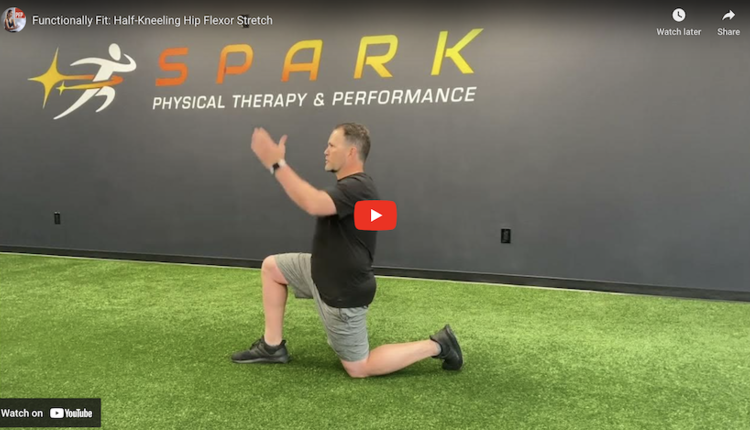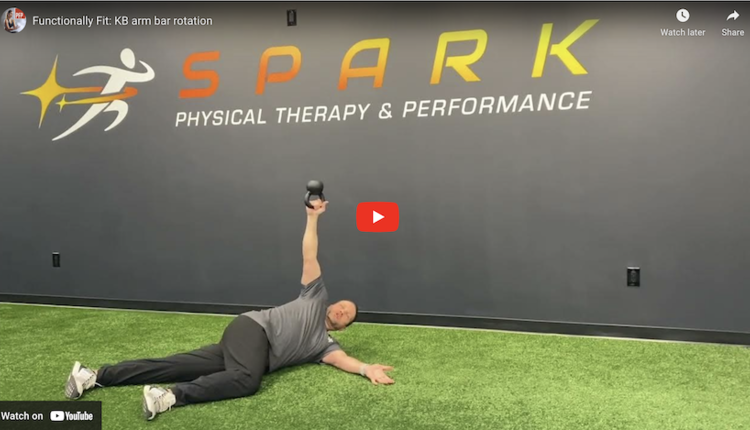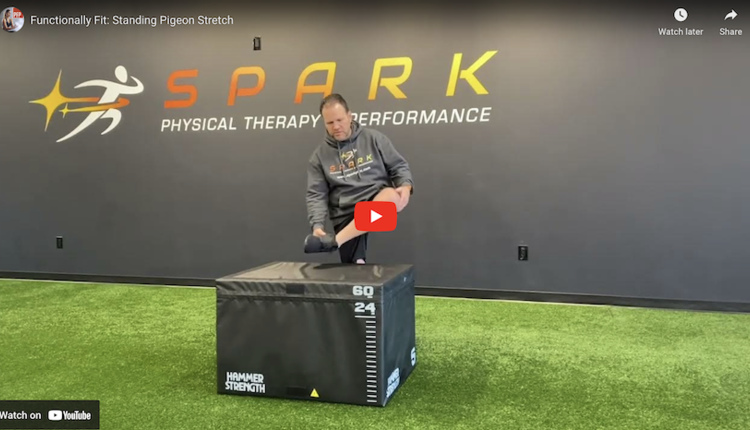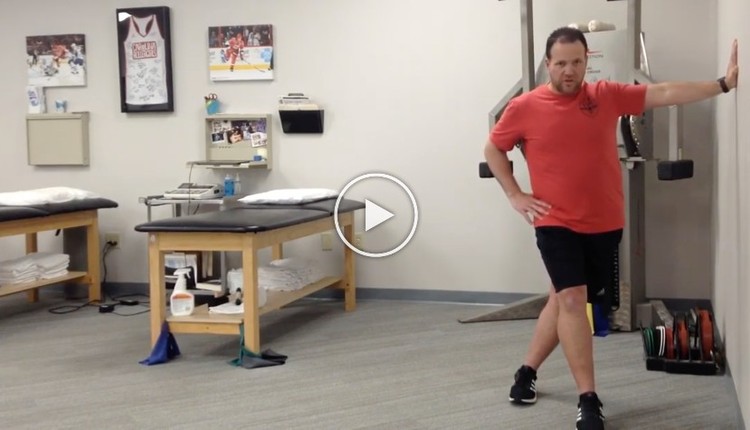 Another installment in a series of exercises featuring BOSU, Brian demonstrates an exercise that promotes shoulder, core and hip stability. Another installment in a series of exercises featuring BOSU, Brian demonstrates an exercise that promotes shoulder, core and hip stability. Note: This exercise can be done in an inclined or declined position. It is an advanced exercise, and clients with any pre-existing upper body restrictions, injuries, or limitations in strength should be screened accordingly. |
Execution:
 For the incline version, position the hands on the BOSU Ballast Ball so that they are beneath the shoulders. The elbows should be stable and close to full extension but do not have to be locked. |
|  Keeping the body still and the core tight, slowly lift one hip into full extension. Pause at the top and then slowly lower back down. For beginners, I suggest alternating legs and allowing a return touch down of the foot. For advanced clientele, I recommend consecutive repetitions on the same leg without allowing the foot to touch back down. Keeping the body still and the core tight, slowly lift one hip into full extension. Pause at the top and then slowly lower back down. For beginners, I suggest alternating legs and allowing a return touch down of the foot. For advanced clientele, I recommend consecutive repetitions on the same leg without allowing the foot to touch back down.
|
| 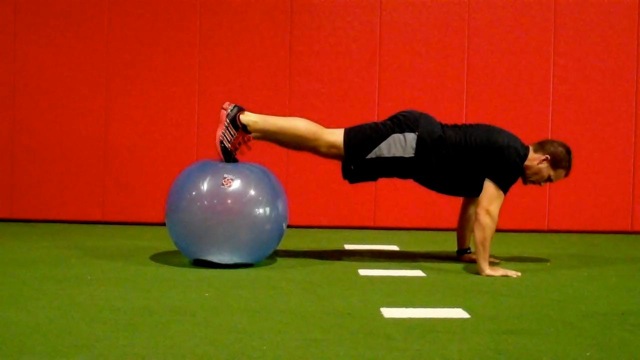 The next progression would be a decline version of the exercise. Now the hands are on the floor (again positioned beneath the shoulders) and the toes resting on top of the BOSU Ballast Ball. If this is too unstable, the dorsum of the feet may be positioned on the BOSU Ballast Ball (the finish to both versions is pictured below). The next progression would be a decline version of the exercise. Now the hands are on the floor (again positioned beneath the shoulders) and the toes resting on top of the BOSU Ballast Ball. If this is too unstable, the dorsum of the feet may be positioned on the BOSU Ballast Ball (the finish to both versions is pictured below).
|
| 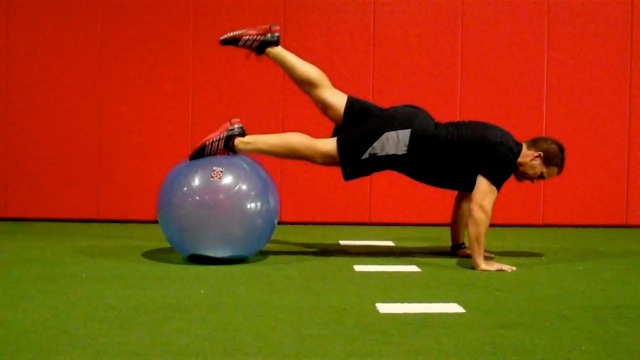 Maintaining a still upper body and core, slowly lift one leg into full hip extension. Pause at the top and return to the start position. Like before, I suggest alternate leg lifts for beginners and consecutive leg lifts for those who are advanced and have enough stability to execute the movement correctly. Maintaining a still upper body and core, slowly lift one leg into full hip extension. Pause at the top and return to the start position. Like before, I suggest alternate leg lifts for beginners and consecutive leg lifts for those who are advanced and have enough stability to execute the movement correctly.
|
|  I suggest performing 1-3 sets of 5-15 repetitions on each side. Quality of the movement and proper alignment and stability should be a primary focus. The speed of movement should be slower and deliberate. I suggest performing 1-3 sets of 5-15 repetitions on each side. Quality of the movement and proper alignment and stability should be a primary focus. The speed of movement should be slower and deliberate.
|
Application: These exercises are intended for advanced users who want or need to challenge shoulder, core and hip stability, while also seeking to improve hip disassociation. In my experience, there may only be a small percentage of clients who can move to this level of difficulty.
The core must function in an anti-extension and anti-rotation fashion throughout, which is a safe and effective way to target those muscles while also providing a demanding strengthening exercise for the upper body and hips.
Precautions: Sufficient upper body strength is a must for this exercise. Clients with wrist pain/weakness or elbow and shoulder pathology should only perform this exercise provided they have are symptom free and have moved through the following progressions.
Incline Version
1. Three (3) point hip extension using a bench (body is inclined)
2. Four (4) point static holds on the BOSU Ballast Ball for no less than 30 seconds
3. Three point incline hip extension with BOSU Ballast Ball
** The client should master the incline version prior to attempting the decline version.
Decline Version
1. Three (3) point hip extension with feet on the bench (body is declined)
2. Four (4) point static holds with feet on the BOSU Ballast Ball
3. Three (3) point decline hip extension (dorsum of feet as support)
4. Three (3) point decline hip extension (toes as support)
Brian Schiff, PT, CSCS, is a licensed physical therapist, respected author and fitness professional. Currently, he serves as the supervisor at the Athletic Performance Center in Raleigh, NC. Brian presents nationally at several professional conferences and seminars on injury prevention, rehab and sport-specific training. For more cutting edge training information, subscribe to his monthly Training & Sports Medicine Update at www.BrianSchiff.com.

 For the incline version, position the hands on the BOSU Ballast Ball so that they are beneath the shoulders. The elbows should be stable and close to full extension but do not have to be locked.
For the incline version, position the hands on the BOSU Ballast Ball so that they are beneath the shoulders. The elbows should be stable and close to full extension but do not have to be locked.
 Keeping the body still and the core tight, slowly lift one hip into full extension. Pause at the top and then slowly lower back down. For beginners, I suggest alternating legs and allowing a return touch down of the foot. For advanced clientele, I recommend consecutive repetitions on the same leg without allowing the foot to touch back down.
Keeping the body still and the core tight, slowly lift one hip into full extension. Pause at the top and then slowly lower back down. For beginners, I suggest alternating legs and allowing a return touch down of the foot. For advanced clientele, I recommend consecutive repetitions on the same leg without allowing the foot to touch back down. The next progression would be a decline version of the exercise. Now the hands are on the floor (again positioned beneath the shoulders) and the toes resting on top of the BOSU Ballast Ball. If this is too unstable, the dorsum of the feet may be positioned on the BOSU Ballast Ball (the finish to both versions is pictured below).
The next progression would be a decline version of the exercise. Now the hands are on the floor (again positioned beneath the shoulders) and the toes resting on top of the BOSU Ballast Ball. If this is too unstable, the dorsum of the feet may be positioned on the BOSU Ballast Ball (the finish to both versions is pictured below). Maintaining a still upper body and core, slowly lift one leg into full hip extension. Pause at the top and return to the start position. Like before, I suggest alternate leg lifts for beginners and consecutive leg lifts for those who are advanced and have enough stability to execute the movement correctly.
Maintaining a still upper body and core, slowly lift one leg into full hip extension. Pause at the top and return to the start position. Like before, I suggest alternate leg lifts for beginners and consecutive leg lifts for those who are advanced and have enough stability to execute the movement correctly. I suggest performing 1-3 sets of 5-15 repetitions on each side. Quality of the movement and proper alignment and stability should be a primary focus. The speed of movement should be slower and deliberate.
I suggest performing 1-3 sets of 5-15 repetitions on each side. Quality of the movement and proper alignment and stability should be a primary focus. The speed of movement should be slower and deliberate.


